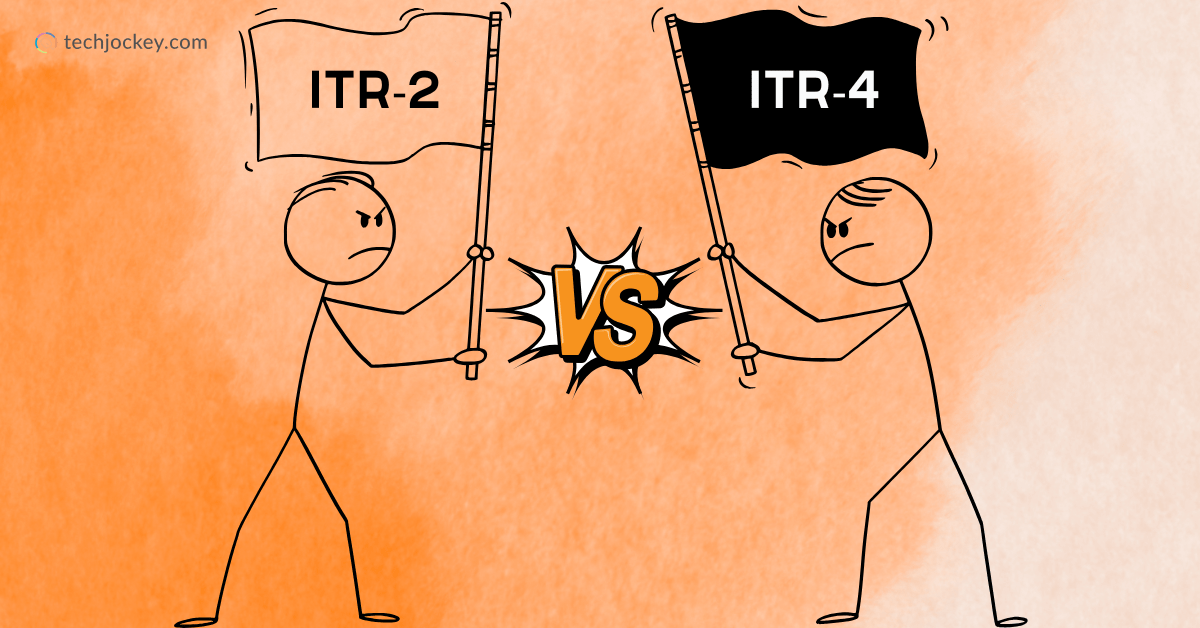
You have got the income. You have got the documents. But which ITR form do you file? It is a standard tax query that many individuals and Hindu Undivided Families (HUFs) face every year. With multiple forms available, it is pretty easy to feel unsure, especially when it comes to choosing between ITR-2 and ITR-4.
For the said two forms might seem similar on the surface to many, but they serve distinct purposes when looked at closely. So, let’s dig deeper and try and discern the difference between ITR-2 vs ITR-4 to make tax filing easier for all.
ITR-2 is designed for individuals and HUFs who have income from sources other than business or profession profits. If your income primarily includes salary, pension, multiple house properties, capital gains, foreign assets or income, or even agricultural income exceeding INR 5,000, ITR-2 is likely the form for you.
To put it simply, ITR-2 is apt for those who…
However, ITR-2 is not for taxpayers with profits and gains from business or profession activities. Those individuals need to consider other forms, depending on their business income reporting method. This makes ITR-2 an extensive form for non-business income sources yet intricate for those with capital gains and foreign assets to report.
Suggested Read: How to File ITR-2 – Step-by-Step Guide
ITR-4, also known as Sugam, on the contrary, is an ITR form meant for resident individuals, HUFs, or firms (other than LLPs) who earn income from business or profession on a presumptive basis. This form is designed to make tax compliance easy for small businesses and professionals, as it allows them to declare income on presumptive taxation schemes under Sections 44AD, 44ADA, and 44AE of the Income Tax Act.
ClearTax Income Tax
Starting Price
Price on Request
ITR-4 suits taxpayers who…
This form caters especially to small traders, freelancers, and professionals who want a simpler compliance process without worrying about paperwork. However, ITR-4 is not suitable if you have income under other heads like multiple house properties or if your income from business/profession does not fall under the presumptive scheme.
Suggested Read: How to File ITR-4 – A Step-by-Step Guide
| Aspect | ITR-2 | ITR-4 (Sugam) |
|---|---|---|
| Eligibility | Individuals & HUFs with **non-business income** | Residents, HUFs & Firms (other than LLPs) with business/professional income under presumptive taxation, income ≤ ₹50 lakh |
| Income Sources | Salary, multiple house properties, capital gains, other sources, foreign assets | Business/professional income under presumptive taxation, salary, one house property, other sources, long-term capital gains (≤ ₹1.25 lakh) |
| Audit & Complexity | Detailed disclosures required; may attract audit if business income exists | Simpler compliance; generally exempt from audit under presumptive scheme |
| Foreign Income | Allowed | Not allowed |
| Capital Gains | Both short-term & long-term allowed | Only long-term capital gains under Section 112A, ≤ ₹1.25 lakh |
| House Property | Multiple properties allowed | Limited to one property |
| Agricultural Income | Exceeding ₹5,000 allowed | Up to ₹5,000 only |
When comparing ITR-2 vs ITR-4, the fundamental differences lie in the following aspects…
Making the right choice between ITR-2 and ITR-4 depends on understanding where your income comes from and how it is reported…
Conclusion
Understanding the ITR-2 vs ITR-4 debate thus is significant for anyone trying to make sense of the tax filing process in India. For only when you choose the right form can you file your taxes properly and on time.
If technical aid is what you seek, give the Techjockey team a call today and get the best income tax software working for you in minutes!
With so much competition in the market, it’s important to make the right decision for… Read More
Artificial Intelligence is changing fast, almost faster than we can keep up. A few years… Read More
‘The global losses due to cybercrime are estimated to hit approximately 10.5 trillion USD per… Read More
With the advent of online shopping, or e-commerce as many term it, we are no… Read More
Today, artificial intelligence is everywhere. It powers apps, automates workflows, and even makes decisions for… Read More
Research says, ‘Retrieval-Augmented Generation (RAG) market is on track to grow from USD 1.2 billion… Read More